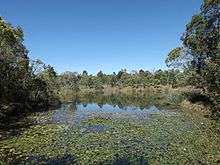Billabong


A billabong (/ˈbɪləbɒŋ/, BIL-ə-bong) is an oxbow lake, an isolated pond left behind after a river changes course.[1] Billabongs are usually formed when the path of a creek or river changes, leaving the former branch with a dead end. Billabongs, reflecting the arid Australian climate in which these "dead rivers" are found, fill with water seasonally and are dry for a greater part of the year.[2]
Etymology
The etymology of the word billabong is disputed. The word is most likely derived from the Wiradjuri term bilabaŋ, which means "a watercourse that runs only after rain" and is derived from bila, meaning "river",[3] and possibly bong or bung, meaning "dead".[4][5] One source, however, claims that the term is of Scottish Gaelic origin.[6]
Billabongs attained significance as they held water longer than parts of rivers and it was therefore important for people to name these areas.[7][8][9]
References in Australian culture
In literature
Once a jolly swagman camped by a billabong,
Under the shade of a coolibah tree,
And he sang as he watched and waited till his billy boiled,
Who'll come a'waltzing Matilda with me
Banjo Paterson's popular song "Waltzing Matilda" is set alongside a billabong, while Mary Grant Bruce wrote a series of books, known as the "Billabong series", in which the adventures of the Linton family, who live at Billabong station from around 1911[10] until the late 1920s, are depicted.[11][12]
In art
Both Aboriginal Australians and European artists use billabongs as subject matter in painting; for example, Aboriginal painter Lance Tjyllyungoo's watercolour painting "Trees at a billabong".[13]
American avant-garde filmmaker Will Hindle produced a short film titled Billabong in 1969.
In commerce
Billabong is the name of an Australian surfwear, skateboard and snowboard brand.
See also
References
- ↑ "Rivers Continuing in Time". Burarra Gathering. Wurdeja, Ji-malawa and Yilan Aboriginal Communities. 21 June 2006. Retrieved 10 April 2013.
- ↑ USGS [Annotated Definitions of Selected Geomorphic Terms and Related Terms of Hydrology, Sedimentology, Soil Science, and Ecology], USGS Open File Report 2008-1217.
- ↑ "billabong." The Macquarie Dictionary. South Yarra: The Macquarie Library Pty Ltd., 2005. Credo Reference. Web. 19 January 2012.
- ↑ A. P. Elkin (June 1967). "Review of Australian English: An Historical Study of the Vocabulary, 1788-1898 by W. S. Ramson". Oceania. Oceania Publications, University of Sydney. 37 (4): 318–319. JSTOR 40329620.
- ↑ "billabong". Dictionary.com. Dictionary.com, LLC. 2013. Retrieved 10 April 2013.
- ↑ Skilton, St J. The Survey of Scottish Gaelic in Australia and New Zealand, p. 300. Quote: A respondent to his survey said: "'Bill' = 'bile' = 'lip or mouth' and 'abong' is from 'abhainn' = 'river' with a parasitic 'G' added. A billabong probably has a mouth shape of sorts being at a bend in a river." University of Fribourg, Switzerland, June 2004. Last accessed 15 March 2008
- ↑ Clarke, R. "Australianisms in 'Waltzing Matilda'", Xamax Consultancy Pty Ltd, 10 December 2003. Last accessed 5 November 2009.
- ↑ Ludowyk, F. "Of Billy, Bong, Bung, & 'Billybong'", Australian National University, no date. Last accessed 15 March 2008
- ↑ "billabong", Merriam-Webster Dictionary Online. Accessed 15 March 2008
- ↑ A Little Bushmaid by Mary Grant Bruce
- ↑ Billabong Adventurers by Mary Grant Bruce
- ↑ Pierce, Peter (2009). The Cambridge history of Australian literature. Cambridge England New York: Cambridge University Press. ISBN 978-0-521-88165-4.
- ↑ "Trees at a billabong". national museum australia. Australian Government. 2013. Retrieved 10 April 2013.
External links
![]() Media related to Billabongs of Australia at Wikimedia Commons
Media related to Billabongs of Australia at Wikimedia Commons